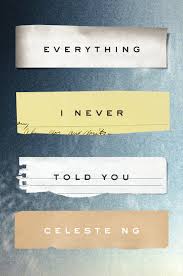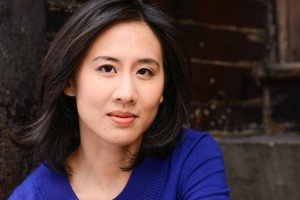 A version of this review appeared in the July 2014 issue of The Practicing Writer.
A version of this review appeared in the July 2014 issue of The Practicing Writer.
One book you’re likely to hear a lot about this summer is a debut novel by Celeste Ng, EVERYTHING I NEVER TOLD YOU, published in late June by Penguin Press. In the words of PUBLISHERS WEEKLY, which awarded the book a starred review back in April, “This emotionally involving debut novel explores themes of belonging using the story of the death of a teenage girl, Lydia, from a mixed-race family in 1970s Ohio.”
I was thrilled to see this pre-publication praise. Although Celeste and I did not meet face-to-face until shortly after it appeared, we’ve been friendly correspondents for years. Celeste had also edited plenty of my blog posts for FICTION WRITERS REVIEW. I’d long admired her writing, and I suspected that when this novel was ready to meet readers, I’d want to help make the introductions. That hunch was confirmed when I read a complimentary galley. I’m delighted that Celeste was willing and able to answer these questions for THE PRACTICING WRITER.
Celeste Ng has also published stories in ONE STORY, TRIQUARTERLY, SUBTROPICS, and many others. Her essays have appeared in KENYON REVIEW ONLINE, THE MILLIONS, and elsewhere. She has been awarded the Pushcart Prize, the Hopwood Award, and a scholarship to the Bread Loaf Writers’ Conference.
Celeste grew up in Pittsburgh, Pennsylvania, and Shaker Heights, Ohio, in a family of scientists. She attended Harvard University and earned an MFA from the University of Michigan (now the Helen Zell Writers’ Program at the University of Michigan). She has taught writing at the University of Michigan and Grub Street in Boston and served as blog editor for the website Fiction Writers Review for three years. Currently, Celeste lives in Cambridge, Massachusetts. To learn more about her and her work, visit celesteng.com or follow her on Twitter (@pronounced_ing).
Please welcome Celeste Ng!
Erika Dreifus (ED): Celeste, please tell us how the idea(s) for EVERYTHING I NEVER TOLD YOU developed.
Celeste Ng (CN): My husband once told me about a school friend of his who—as a boy—had pushed his own little sister into a lake. She was rescued, but I kept thinking about what it might have been like for her to fall into the water, what the dynamic between this brother and sister might have been like (both before and after) and what would have happened in her family if she had not been saved. The image of a girl plunging underwater stayed with me and morphed, as story seeds often do, into something quite different.
ED: I don’t know your exact age, Celeste, but I know when you finished college, and I am pretty sure that you weren’t yet born in 1976, when the narrative present of EVERYTHING I NEVER TOLD YOU is set. Please tell us a bit about the research that contributed to your evocation of this temporal setting.
CN: You’re right, I wasn’t quite born in 1976—but I grew up in the ’80s in a little suburb with a small-town feel. Whether it was the town or just my family that was slightly behind the times, I’m not sure, but the 1970s setting didn’t feel foreign to me. I filled in the scenes with items that I remember from my childhood home: telephones with rotary dials and spiral cords, record players that sometimes needed a stack of pennies to weight the needle, cars with stickshifts and roll-up windows and actual cigarette lighters. Even some of the clothes the characters wear are based on hand-me-downs I got from my sister—my family didn’t believe in throwing things away.
I did have a lot of fun doing research for the earlier sections—set in 1966 and before: watching the broadcast news coverage of the Gemini 9 mission on YouTube, looking at old cookbooks—Marilyn’s is based on my mom’s own Betty Crocker, reading about the experience of women at Radcliffe in the 1950s, and so on. (I collected those bits of research on a Pinterest page, if readers are interested!)
ED: At its heart, this is a novel about a family, its tragic (and mysterious) loss, and its grief. But it’s also a story about an interracial marriage that begins, as the novel notes, several years before the United States Supreme Court, in Loving v. Virginia, invalidated laws against such marriages in 1967. And throughout the novel, we see numerous instances of prejudice–some explicit and some more subtle–against Asian-Americans. Please tell us a bit about what you hope readers may take away from this element of the novel.
CN: While I was growing up—first outside of Pittsburgh, then outside of Cleveland—there were virtually no other Asians in my community. It’s an extremely weird experience to look very different from everyone else around you. It can be draining and disorienting to feel so conspicuous, to have others instantly perceive you as different—especially if you, inside, feel part of the group. I hope the novel will get readers thinking about what that might be like, especially if they’ve never had that experience themselves.
And I hope readers will think about issues of culture and identity in a broader sense, too. It’s shocking to me that interracial marriages were illegal as late as 1967—that’s really just a generation or two ago. (My own marriage is interracial, and my son is biracial, so these issues are very much on my mind personally.) Even more shocking is that negative attitudes towards marrying outside of one’s race—and towards Asians in general—still persist more than you’d think. Since 1958, Gallup has regularly polled people on their attitude towards interracial marriage, and only in 1997 did a majority of Americans approve of it. A landmark 2001 study on attitudes towards Asian Americans found that 68% of Americans had a “somewhat negative” or “very negative” view of Asian Americans; that more Americans were uncomfortable supporting an Asian American for president than a black, Jewish, or woman candidate; and that 24% disapproved of intermarriage with an Asian American. A 2009 followup found numbers had improved, but only somewhat. Sorry for all the figures, but I find those numbers really startling. We’re making progress, but there’s still a long way to go.
ED: Which character was most difficult to write (and why)?
CN: Lydia. We often talk about how story arises from a character’s desire, how as writers, we need to know what a character wants and have them strive to get it. Marilyn, of course, desperately wants a career in the sciences (first for herself, and then for her daughter) while James wants to be socially accepted. Nath wants to go into space, and Hannah wants to be noticed. But in early drafts, I didn’t think Lydia had a clear-cut desire—she was largely defined by others’ plans for her—and that made her very hard to write: she felt very passive. Partway through writing the novel, though, I realized that what Lydia wants above anything, even her own happiness, is to please her parents. That’s what drives all her actions and decisions. Once I understood that, she became a lot easier to write—and a lot more interesting.
ED: You’re currently listed as Editor-at-Large for Fiction Writers Review. Please tell us a bit about FWR–how you became involved with it and why it has been important to you.
CN: Fiction Writers Review is a website founded in 2008 by Anne Stameshkin, a classmate of mine from the University of Michigan’s MFA program. As newspaper review sections folded, Anne’s idea was to create a space for reviews of fiction, interviews with fiction writers, and craft essays—all written by fiction writers. The site’s name is a nod to that: it’s both a review (i.e., journal) for fiction writers, and a place where fiction writers review books. Its philosophy about why fiction matters is summed up by an Ian McEwan quote: “Imagining what it is like to be someone other than yourself is at the core of our humanity. It is the essence of compassion, and it is the beginning of morality.”
In the early days, it was a one-woman show, with Anne soliciting pieces, assigning reviews, and doing all the blogging. Anne asked me to write an essay for the site’s launch, and over the next year I wrote several reviews for FWR, but behind the scenes I kept emailing Anne with tidbits of literary news as blog fodder. I think I was more of a nuisance than a help! After a while, Anne suggested that I write some blog posts myself, and in 2009 I took over as blog editor.
I stepped away in 2012 (partly so I could finally finish my novel!) but the site remains important to me. It’s where I wrote my first essays and reviews, and where I first learned to blog. It gave me the chance to work with many writers I’d already admired–including you, Erika!—and introduced me to many new writers as well. The site is now being run by editor Jeremiah Chamberlin, and I look forward to watching it continue to grow.
ED: Anything else you’d like to share with us?
CN: Whenever I have a hard time writing, I recall something Ann Patchett said in her keynote address at Grub Street’s 2009 Muse and the Marketplace conference: “The Muse is bullshit. Get your work done.” It’s one of the best pieces of writing advice I know: sometimes, you just have to stop waiting for inspiration and get to work.
ED: Thank you so much, Celeste.
